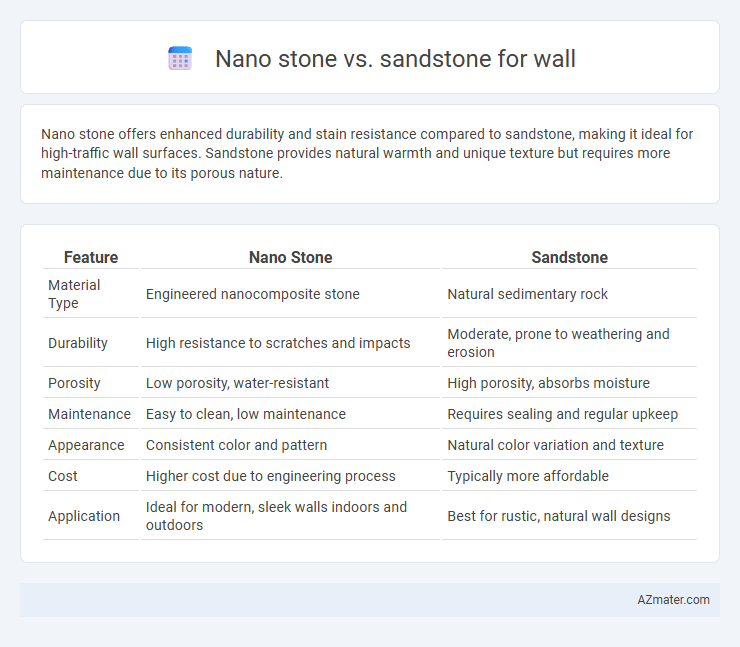Nano stone offers enhanced durability and stain resistance compared to sandstone, making it ideal for high-traffic wall surfaces. Sandstone provides natural warmth and unique texture but requires more maintenance due to its porous nature.
Table of Comparison
| Feature | Nano Stone | Sandstone |
|---|---|---|
| Material Type | Engineered nanocomposite stone | Natural sedimentary rock |
| Durability | High resistance to scratches and impacts | Moderate, prone to weathering and erosion |
| Porosity | Low porosity, water-resistant | High porosity, absorbs moisture |
| Maintenance | Easy to clean, low maintenance | Requires sealing and regular upkeep |
| Appearance | Consistent color and pattern | Natural color variation and texture |
| Cost | Higher cost due to engineering process | Typically more affordable |
| Application | Ideal for modern, sleek walls indoors and outdoors | Best for rustic, natural wall designs |
Introduction to Nano Stone and Sandstone
Nano stone is a revolutionary composite material known for its ultra-fine particles, enhanced durability, and resistance to stains and scratches, making it ideal for sleek, modern wall designs. Sandstone, a natural sedimentary rock composed mainly of sand-sized mineral particles, offers a warm, rustic aesthetic with its porous texture and earthy tones, commonly used in traditional and outdoor wall cladding. Comparing their physical properties and aesthetic versatility helps determine the best choice for specific wall applications.
Composition and Properties Comparison
Nano stone is composed of engineered materials combining natural minerals with nanotechnology-enhanced resins, resulting in a dense, non-porous surface that offers superior durability and stain resistance compared to sandstone, which is a natural sedimentary rock primarily made of quartz or feldspar grains. Sandstone exhibits higher porosity, which makes it more susceptible to water absorption and weathering, whereas nano stone's compact molecular structure provides enhanced hardness and resistance to scratching, making it ideal for both interior and exterior wall cladding. The chemical stability and low maintenance of nano stone contrast with sandstone's vulnerability to erosion and requirement for periodic sealing to preserve its aesthetic and structural integrity.
Aesthetic Appeal and Design Versatility
Nano stone offers a sleek, modern aesthetic with a uniform texture and rich color depth that enhances contemporary wall designs. Sandstone provides a natural, earthy appearance with unique grain variations, ideal for rustic or traditional settings. Both materials offer design versatility, but nano stone's precision manufacturing allows for seamless integration in minimalist and high-end architectural projects.
Durability and Longevity
Nano stone offers superior durability compared to sandstone due to its advanced composite materials that resist chipping, cracking, and weathering over time. Sandstone, while aesthetically pleasing with its natural texture, is more porous and susceptible to erosion, reducing its longevity in exterior applications. For long-term wall installations, nano stone provides enhanced structural integrity and requires less maintenance, ensuring a longer lifespan.
Water and Weather Resistance
Nano stone exhibits superior water resistance compared to sandstone, thanks to its engineered nanotechnology surface that repels moisture and prevents water absorption. Sandstone, a natural sedimentary rock, tends to be more porous and susceptible to water infiltration, leading to potential weathering and erosion over time. For exterior wall applications in climates with frequent rain or freeze-thaw cycles, nano stone offers enhanced durability and weather resistance, reducing maintenance costs and preserving the wall's structural integrity.
Maintenance and Cleaning Requirements
Nano stone walls require minimal maintenance due to their non-porous surface that resists stains, dirt, and algae growth, making cleaning quick and easy with just water and mild detergent. Sandstone, being porous, demands more frequent sealing to prevent moisture penetration and staining, and typically needs specialized cleaning products to remove dirt and biological growth. Over time, sandstone walls may require periodic restoration to maintain their appearance, whereas nano stone retains its look with less effort and cost.
Installation Process and Costs
Nano stone offers a simpler installation process compared to sandstone due to its lightweight, flexible panels that reduce labor time and complexity. Sandstone requires skilled masonry work, heavy handling, and longer curing times, increasing installation duration and labor costs. The overall cost of nano stone installation is generally lower, though sandstone material prices vary widely based on quality and sourcing.
Environmental Impact and Sustainability
Nano stone offers a significantly lower environmental impact compared to sandstone due to its production process, which consumes less water and energy while generating fewer carbon emissions. Sandstone extraction involves quarrying that leads to habitat disruption and soil erosion, contributing to reduced biodiversity. Nano stone's durable and lightweight properties enhance sustainability by reducing transportation emissions and extending the lifespan of wall installations.
Popular Applications in Wall Cladding
Nano stone offers superior durability and water resistance, making it ideal for exterior wall cladding in harsh weather conditions, while sandstone is prized for its natural aesthetic and breathability, commonly used in interior accent walls and heritage building facades. Nano stone's dense composition allows for slimmer profiles and innovative designs, favored in modern commercial and residential buildings. Sandstone remains popular in restoration projects and rustic wall claddings due to its warm texture and variety of earthy tones.
Choosing the Right Material: Nano Stone vs Sandstone
Nano stone offers superior durability and resistance to weathering compared to sandstone, making it ideal for exterior wall cladding in harsh climates. Sandstone provides natural aesthetic appeal and excellent thermal insulation but requires more maintenance due to its porous nature. Selecting between nano stone and sandstone depends on priorities like longevity, appearance, and environmental conditions of the installation site.

Infographic: Nano stone vs Sandstone for Wall
 azmater.com
azmater.com